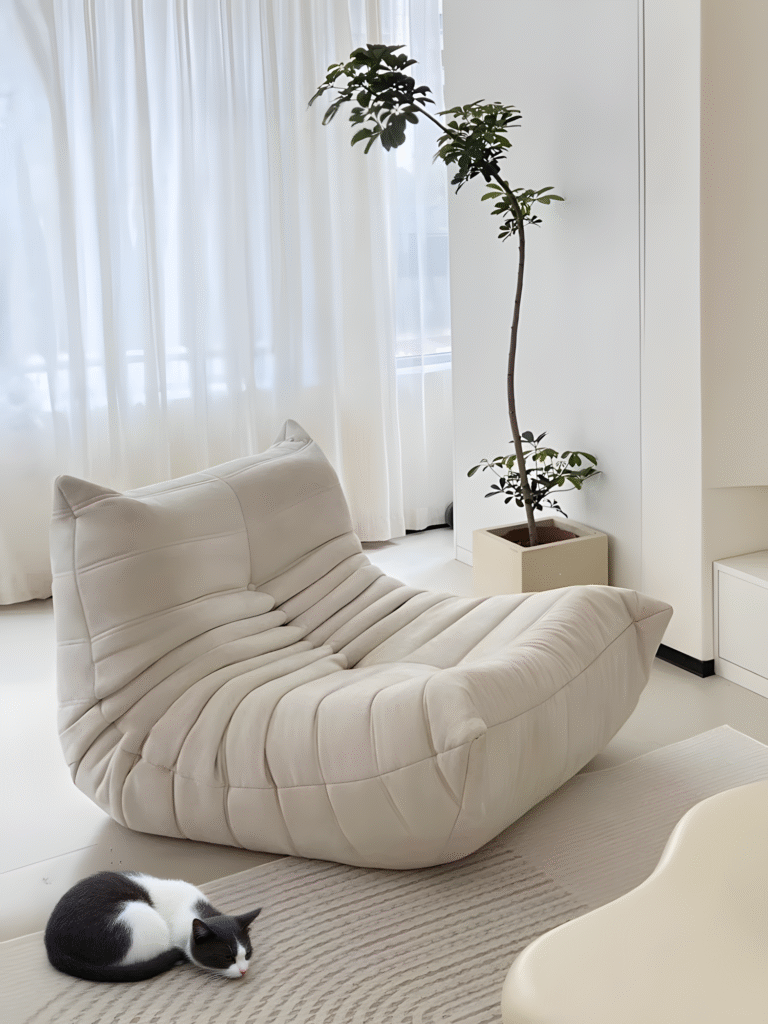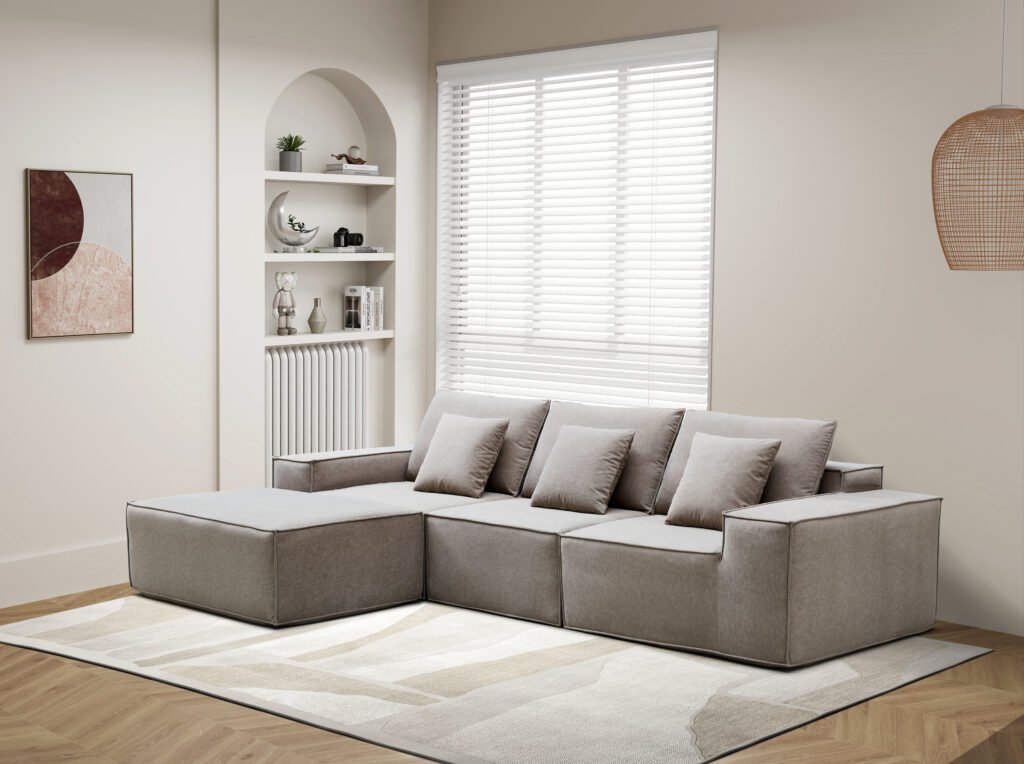Heat-treating foam before compressing a sofa is a critical step in ensuring the foam’s resilience, durability, and comfort after packaging and unpacking. Proper heat treatment softens and conditions the foam, allowing it to compress without damage and recover fully once decompressed. This process requires careful control of temperature, timing, and environment to avoid degrading the foam’s structure.
In this comprehensive guide, we explore the science behind foam heat treatment, step-by-step safe methods, best practices, and how industry leaders like Modular-Sofas.com implement these techniques to deliver high-quality compressed sofas.


Why Heat-Treat Foam Before Compression?
Foam used in sofas—typically polyurethane or memory foam—contains air cells that provide cushioning. When compressed, these cells are squeezed, and without proper preparation, the foam can develop cracks, permanent deformation, or lose elasticity.
Heat treatment benefits include:
- Softening foam cells: Makes foam more pliable and easier to compress.
- Reducing internal stresses: Prevents micro-tears and damage during folding.
- Improving foam recovery: Enhances the foam’s ability to rebound after unpacking.
- Extending foam lifespan: Maintains comfort and support over time.
Understanding Foam Types and Their Heat Sensitivities
Different foam types respond uniquely to heat:
- Polyurethane Foam: Common in sofas, sensitive to high temperatures; requires moderate heat treatment.
- Memory Foam: Viscoelastic foam that softens with heat but can degrade if overheated.
- Latex Foam: More heat resistant but still benefits from controlled heat treatment.
- High-Resilience Foam: Durable foam that tolerates heat well but should be treated carefully to avoid breakdown.
Safe Heat-Treatment Methods for Foam
1. Controlled Oven Heating
- Temperature Range: 60°C to 80°C (140°F to 176°F) to soften foam without damage.
- Duration: 30 minutes to 2 hours depending on foam thickness.
- Process: Place foam in a clean, ventilated oven on a flat surface. Avoid direct contact with heating elements.
- Monitoring: Use a thermometer to ensure consistent temperature; avoid overheating.
2. Steam Treatment
- Method: Expose foam to steam in a controlled environment.
- Benefits: Moist heat softens foam gently and evenly.
- Duration: Typically 10 to 30 minutes.
- Precautions: Avoid excessive moisture buildup that can damage foam or promote mold.


3. Infrared Heating
- Technology: Uses infrared lamps to heat foam surface evenly.
- Advantages: Precise temperature control and energy efficiency.
- Application: Suitable for thin foam layers or spot treatment.
4. Hot Water Bath (For Certain Foam Types)
- Method: Brief immersion in hot water (not boiling) followed by drying.
- Use: Rarely used due to risk of water absorption but applicable for some latex foams.
- Drying: Thorough drying is essential to prevent mold.
Step-by-Step Guide to Heat-Treat Foam Before Compression
- Prepare the Foam: Remove any covers or attachments. Ensure foam is clean and dry.
- Select Heat Treatment Method: Choose oven, steam, infrared, or hot water bath based on foam type.
- Set Temperature and Time: Follow recommended ranges to avoid overheating.
- Heat the Foam: Place foam in the heating device, monitoring temperature carefully.
- Cool Down: Allow foam to cool gradually at room temperature to stabilize structure.
- Inspect Foam: Check for any signs of damage, discoloration, or odor.
- Compress and Package: Once treated, fold and vacuum-seal foam carefully to avoid damage.
Common Mistakes to Avoid During Heat Treatment
- Overheating: Can cause foam melting, discoloration, or odor.
- Uneven Heating: Leads to inconsistent softness and potential weak spots.
- Excess Moisture: Promotes mold and foam degradation.
- Rapid Cooling: Thermal shock can damage foam cells.
- Ignoring Foam Type: Applying uniform heat to all foams can cause damage.
How Modular-Sofas.com Implements Foam Heat Treatment
At Modular-Sofas.com, we utilize industry-leading heat treatment protocols to ensure our compressed sofas maintain optimal comfort and durability:
- Customized Heat Profiles: Tailored heat treatment based on foam composition and density.
- Advanced Equipment: Use of precision ovens and steam chambers for consistent results.
- Quality Control: Rigorous inspection post-treatment to detect any foam defects.
- Sustainable Practices: Energy-efficient heating methods to reduce environmental impact.
- Expert Training: Skilled technicians trained in foam handling and heat treatment.
Table: Heat Treatment Methods for Foam – Comparison and Recommendations
| Method | Temperature Range | Duration | Advantages | Limitations | Best For |
|---|---|---|---|---|---|
| Oven Heating | 60°C - 80°C (140°F - 176°F) | 30 min - 2 hrs | Even heating, easy control | Risk of overheating if unchecked | Polyurethane, high-resilience foam |
| Steam Treatment | ~100°C steam | 10 - 30 min | Gentle, uniform softening | Moisture risk, requires drying | Memory foam, latex foam |
| Infrared Heating | Variable (controlled) | Minutes | Precise, energy efficient | Limited penetration depth | Thin foam layers, spot treatment |
| Hot Water Bath | 50°C - 60°C (122°F - 140°F) | Minutes | Softens latex foam | Water absorption risk | Latex foam |
Best Practices for Compressing Foam After Heat Treatment
- Fold Gently: Avoid sharp bends that can stress foam cells.
- Use Vacuum Sealing: Remove air carefully to maintain compression without damage.
- Store Properly: Keep compressed foam in dry, temperature-controlled environments.
- Allow Expansion Time: After unpacking, let foam regain shape gradually.
- Regular Quality Checks: Inspect foam before and after compression for defects.
Environmental and Safety Considerations
- Ventilation: Heat treatment areas must be well-ventilated to avoid buildup of fumes.
- Temperature Monitoring: Use calibrated sensors to prevent overheating.
- Fire Safety: Foam is flammable; avoid open flames or sparks near heating equipment.
- Waste Management: Dispose of any damaged foam responsibly.


Troubleshooting Common Issues
| Issue | Cause | Solution |
|---|---|---|
| Foam Melting or Warping | Excessive heat or uneven heating | Lower temperature, improve heat distribution |
| Mold or Mildew | Excess moisture during steam or water bath | Ensure thorough drying, use dehumidifiers |
| Loss of Elasticity | Overheating or prolonged heat exposure | Reduce heat exposure time |
| Odor Development | Chemical breakdown from heat | Use lower temperatures, ventilate area |
Why Heat Treatment Matters for Sofa Comfort and Longevity
Proper heat treatment ensures that foam cushions:
- Retain resilience and bounce.
- Resist permanent compression marks.
- Provide consistent comfort over years.
- Withstand the stresses of compression and unpacking.
Conclusion
Heat-treating foam before compressing a sofa is a vital process that enhances the foam’s flexibility, durability, and comfort retention. By carefully controlling temperature, duration, and method, manufacturers can prevent damage and ensure customers receive sofas that look and feel great after unpacking.
Modular-Sofas.com leads the industry with advanced foam heat treatment protocols, combining technology and expertise to deliver premium compressed sofas. Following the guidelines outlined in this article will help manufacturers and consumers alike understand the importance of safe heat treatment and proper compression techniques.